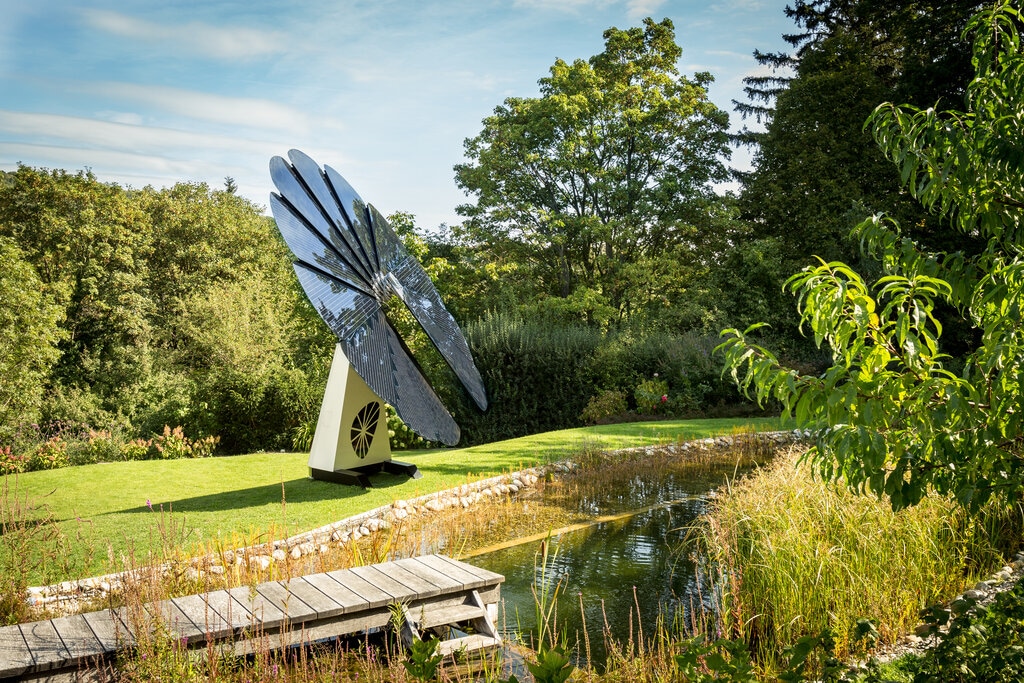Smart solar flowers or Smartflower are large, mechanical bloom with solar panels for “petals.” Some customers prefer this crafty invention over traditional rooftop panels. Here’s why.
—
Smart solar flowers and trees are revolutionising the solar power industry by how they capture energy from the sun. The Smartflower features an array of panels, unfurling in the morning and rotating with the sun throughout the day. They fold up at night when their operation is unnecessary.
This mechanical device that looks like a large flower can capture the sun’s rays and convert them into electricity. This innovative technology sounds like a worthy investment, but is it?
Solar flowers and trees are made for the purpose of decoration while they provide renewable energy for homes and businesses. However, many people considering the installation of solar panels wonder how practical these structures are for energy production. Here’s everything you need to know about these powerful plants.
What Can Smart Solar Flowers and Trees Provide?
Smartflowers are solar installations mounted into the ground. It is a freestanding structure that’s fully assembled upon delivery. The solar flowers have panels for petals and the trees feature branches with panels on top. Some solar trees are also built as a single tower with a photovoltaic panel mounted on top.
Solar flowers have 12 petals rotating at a 90-degree angle, producing 40% more energy than fixed solar panels. They work with a dual-axis tracking system, so they always face the sun — increasing productivity by up to 10%. Their elevated design also allows the panels to cool naturally, increasing their efficiency.
In addition, solar plants can benefit cities aiming to procure a green infrastructure. They can reduce energy usage and fossil fuel consumption when combining solar panels and natural elements. Essentially, a biosolar installation would transform an urban environment, resulting in a healthier and cleaner place to live. They also provide visual appeal and are better able to blend into their environments, appearing as just part of the landscape.
Smartflower vs Traditional Solar
Solar flowers and traditional systems both produce clean, renewable energy. However, they have several differences that are worth noting.
A Smartflower can produce 2.5 kW, equating to USD$10 per watt. On the other hand, traditional rooftop solar systems generate 4 kW, which comes down to USD$6.50 per watt. Some traditional solar systems can also vary by around USD$3.50 per watt.
In comparison, the solar flower is much more expensive than a conventional solar roof panel. While the costs could be a setback for some, the solar flower does have quite a few perks that may offset the expense.
You might also like: 12 Solar Energy Facts You Might Not Know About
The Pros and Cons of Solar Plants
Solar flowers and trees have a self-cleaning system where debris falls off as the petals collapse at night. This feature is optimal since dirt can harden on stationary panels — making them more difficult to clean over time.
Moreover, a Smartflower installation takes only two to three hours, whereas rooftop solar installations can take up an entire day. Solar flowers are also easily movable and can be transported to different locations.
One drawback of the solar flower is that it needs a fairly large area for operation – at least 17 feet of clear space in diameter. Therefore, Smartflowers are the least ideal for large housing developments with small lots. However, solar trees are perfect for places that don’t have much space – making this a more attractive option for neighbourhoods and urban environments.
The costs are typically greater since this technology is new, especially when there is a low supply. However, the price could eventually come down once demand and production increase. Those who anticipate these systems should monitor for a better price point.
Is the Smartflower a Worthy Option?
A solar tree or flower sculpture can significantly impact your commitment to sustainability. Suppose you’re willing to pay a premium for ground-mounted solar systems and have the space for it. That makes these installations a great option, especially if you aren’t too concerned about meeting your entire home’s electrical needs.
In addition, customers can receive a 26% federal solar tax credit. The technology can also make a great conversation piece, adding tasteful aesthetics to a homeowner’s property. However, if you have practicality in mind, the Smartflower may not be a sensible choice.
While solar flowers can produce more energy at certain times than fixed arrays, this could be an advantage – especially as utilities add consumption and pricing in the early evening. There’s also the added peace of mind to a ground mount. Solar roof panels can cost extra for reinstallation when roof repairs are needed.
Going Solar With Smartflowers
The Smartflower is a great choice for those who like the rotating panels and unique look. Furthermore, solar flowers and trees can create a visual statement for businesses showcasing their commitment to greener operations. While other economical options are available, solar flowers and trees could be worth the investment if you’re willing to spend the upfront cost.
EO’s Position: The world is rapidly losing sight of being able to stay under the 1.5C limit of global temperature rise to avoid the catastrophic impacts of climate change. We need to rapidly scale up renewable energy generation as quickly as possible. While smart solar flowers is still an emerging tech, with strong investment and inter-connected regional grids, solar has the potential to become the baseload generator of renewable energy in the US.
Featured image courtesy of Smartflower


















